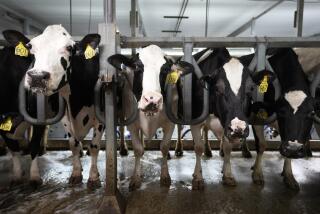Acton Antique Dealer Is Milking a Fad
- Share via
ACTON — Antiques dealer Dennis Neice discovered the curious draw of fiberglass farm animals long before they became the latest fad in whimsical outdoor art.
For years, Neice’s life-size horses, cows and steers perched stoically atop a fence at his rural outpost--the Barnyard--have been a familiar sight to travelers along the 14 Freeway between the San Fernando and Antelope valleys.
“A lot of people just love them,” said Neice, who reports selling 75 to 100 of the creatures yearly, ranging in price from $850 to $1,500. He said about half of his sales are to homeowners who plop the statues in yards, adding a bit of country to their suburban landscapes sure to draw a double-take from passersby.
Neice doesn’t advertise his business, even on the Internet. Nor does he keep regular hours at the Barnyard, just north of the freeway at Crown Valley Road. The business phone number is unlisted. Yet he said he profits quite well just from word-of-mouth referrals.
“Being out on that freeway all these years, people just know I’m there,” said Neice, whose two-acre yard is crammed with hundreds of old wagon wheels. Half of his buyers are referrals and casual drop-ins, and the other half include entertainment studios and theme park operators. He currently is supplying props for new theme parks in Hong Kong and Tokyo, he said.
But it is the demand for cows that has perked up sales by about 10% in recent months, he said.
Fiberglass Creatures Need Minimal Care
The animals are cropping up everywhere: next to swimming pools in Bel-Air and in frontyards in the Hollywood Hills.
“You don’t have to feed them. They don’t freeze, and you don’t have to muck,” said Neice, a self-described “hillbilly” from the Cumberland mountains of Kentucky.
Neice also has an expansive menagerie at his three-acre mini-ranch in Santa Clarita. In addition to cows--both a full-size and miniature Holstein--he has a horse, steers, bears, even an 8-foot-tall rooster.
“The rooster serves as kind of a mascot around here,” he said, adding that neighbors have adopted the 250-pound rooster as a signpost in directing visitors to their homes.
“Some people at first thought it was a bit odd,” said Neice, strolling by a plastic horse tied to an oak outside his Santa Clarita home. “But the kids all love it.”
Now that Neice has been collecting for more than 30 years, his make-believe farm is populated by more than just the animals that he regularly repositions in the corral. He also has Knott’s Berry Farm cowboy and saloon girl mannequins lounging around antique autos, wagons and other collectibles, such as a Gilmore gasoline pump and a coffee bean grinder from the 1800s.
He has even built a cabin reminiscent of his Kentucky home that he left at age 15, unable to read or write.
“Nobody went to school,” said Neice, one of 12 children.
Television shows lured him to California, where he became literate by attending night classes at Van Nuys High while working at a used-furniture store.
“I got what I had to have, and I’m still learning,” said Neice, now 55 and a successful businessman with income properties. He includes among his collection numerous vintage automobiles. His wife, Jan, is an electronics buyer who travels worldwide, as does Neice.
The Acton collector’s affinity for the old and the odd is catching on in mainstream America.
Cow Exhibits Raise Funds for Charities
The fiberglass cow craze began in 1998 in Zurich, spread to Chicago last year, then this summer hit New York, Stamford, Conn., and a dozen other cities across the nation.
“This has become a real cult art,” said Jerry Elbaum, president of CowParade Holdings Corp. of West Hartford, Conn., producer of exhibits underway in New York, Stamford and West Orange, N.J. He is planning similar productions next year in Hawaii, Missouri, Kansas, Texas, England and Australia.
The exhibits are staged as public art shows that raise hundreds of thousands of dollars for local charities and bring tourist dollars into area economies.
Sponsors purchase cows that are decorated by artists and placed in public areas around downtowns, then auctioned off to collectors. Tourists flock to see the exhibits, which continue for months.
“The cow is a three-dimensional canvas,” explained Elbaum, who described the works created by artists, including some highly acclaimed, as “most magnificent.”
The fad has triggered an international demand for the inanimate beasts, which will be auctioned for the first time on the Internet beginning Sept. 29 at https://www.amazon.com/cowparade-auction.
CowParade New York 2000 features more than 500 fiberglass cows with such pun-intended themes as “Lady Liberty Heifer,” “Moo York Milly,” “Moozart,” “Prima Cowlerina and “Cow-mmodities Trader.”
The craze for fiberglass animals has expanded to pigs in Cincinnati, horses in Lexington, moose in Toronto, lizards in Orlando and fish in New Orleans.
CowParade’s bovines are being manufactured by a Los Angeles firm, Silvestri Inc., which competes with about a dozen other manufacturers nationwide.
Neice, however, declines to disclose who makes his animal molds and figures, explaining that his partner is semiretired. “He’s already busy enough. He makes them just for me when I need them and nobody else.”
Times Librarian Ron Weaver contributed to this story.
More to Read
Inside the business of entertainment
The Wide Shot brings you news, analysis and insights on everything from streaming wars to production — and what it all means for the future.
You may occasionally receive promotional content from the Los Angeles Times.










